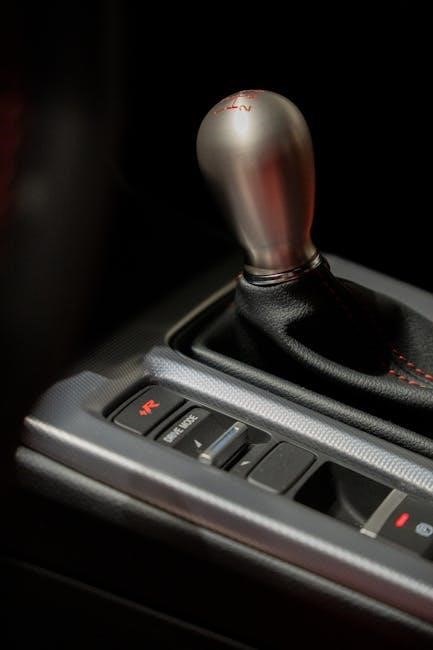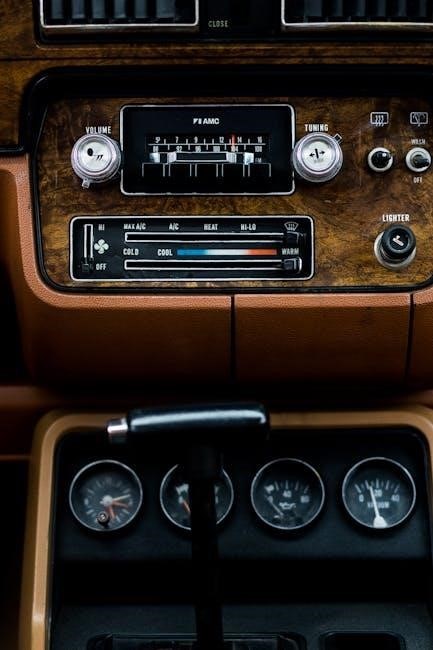Small manual transmissions offer a direct connection between driver and vehicle, ideal for compact cars. They remain popular in budget-friendly and enthusiast-focused models despite declining popularity;
Definition and Overview
A small manual transmission is a gear-shifting system that requires driver input to change gears, typically using a clutch pedal and shift lever. Designed for compact vehicles, these transmissions are lightweight, simple, and cost-effective. They usually feature 5 or 6 forward gears and a reverse gear, providing precise control over speed and torque. Manual transmissions are favored for their fuel efficiency, lower production costs, and driver engagement, making them a practical choice for budget-friendly and enthusiast-focused cars. They remain a vital component in modern automotive design.
Importance in Modern Vehicles
Small manual transmissions hold significant importance in modern vehicles, offering a blend of affordability, fuel efficiency, and driver engagement. They are particularly valued in compact cars, where their lightweight design enhances performance and reduces production costs. Enthusiasts appreciate the control and connection manual transmissions provide, while budget-conscious buyers benefit from lower purchase and maintenance expenses. Despite the rise of automatics, manual transmissions remain a preferred choice for those seeking a more interactive driving experience and cost-effective mobility in an era focused on efficiency and connectivity.

Benefits of Small Manual Transmissions
Small manual transmissions offer lower costs, improved fuel efficiency, and a more engaging driving experience. They provide better control and connection to the vehicle, enhancing overall performance.
Fuel Efficiency and Cost-Effectiveness
Small manual transmissions are known for their fuel efficiency, often outperforming automatic counterparts in compact vehicles. By allowing drivers to control engine RPMs, they optimize energy use, reducing fuel consumption. This makes them a cost-effective choice for budget-conscious drivers. Additionally, manual transmissions typically have lower purchase prices and maintenance costs compared to automatics, further enhancing their economic appeal. Cars like the Honda Civic Si and Subaru Impreza exemplify these benefits, combining efficiency with affordability.
Driver Engagement and Control
Small manual transmissions foster a deeper connection between the driver and the vehicle, offering precise control over gear shifts and engine performance. This hands-on interaction enhances driving engagement, allowing drivers to tailor their driving style to road conditions. Whether navigating city streets or winding roads, the tactile experience of shifting gears provides a sense of involvement that automatics often lack. Enthusiasts particularly appreciate this direct link, making manual transmissions a preferred choice for those who value the joy of driving over convenience.
Reliability and Simplicity
Small manual transmissions are renowned for their reliability and straightforward design. With fewer components compared to automatics, they are less prone to mechanical failures and require less complex maintenance. Their simplicity reduces long-term ownership costs and enhances durability, making them a practical choice for budget-conscious drivers. Additionally, the compact size of these transmissions allows for efficient integration into smaller vehicles, ensuring optimal performance without compromising space or fuel efficiency. This durability and ease of maintenance make manual transmissions a dependable option for everyday driving.
Popular Small Cars with Manual Transmissions
Honda Civic Si, Subaru Impreza, Volkswagen Golf, and select Hyundai models are top choices for compact vehicles offering manual transmissions, blending performance, affordability, and driver engagement.
Honda Civic Si: Performance and Affordability
The Honda Civic Si stands out as a standout model, offering a perfect blend of performance and affordability. It features a six-speed manual transmission paired with a 200-hp turbocharged 1.5-liter engine, delivering 192 lb-ft of torque. This combination ensures both power and efficiency, making it a favorite among enthusiasts. With a starting price around $30,000, the Civic Si provides an engaging driving experience, precise handling, and excellent fuel economy, making it a top choice for those seeking a sporty yet practical compact car.
Subaru Impreza: All-Wheel Drive with a Manual Option
The Subaru Impreza is a standout model offering a rare combination of all-wheel drive and a manual transmission. This feature is unique in the compact car segment, where most models prioritize automatic or CVT options. The Impreza’s manual gearbox appeals to driving enthusiasts seeking control and connection to the road. Paired with Subaru’s renowned Symmetrical All-Wheel Drive, it delivers exceptional traction and stability, making it a versatile choice for various driving conditions while maintaining affordability and reliability.
Volkswagen Golf: A Compact Car with a Manual Gearbox
The Volkswagen Golf is a prime example of a compact car offering a manual transmission, blending sporty dynamics with practicality. Its manual gearbox provides precise shifting and driver engagement, appealing to enthusiasts; Known for its balance of performance and efficiency, the Golf remains a popular choice for those seeking a fun yet versatile driving experience. With its compact design and affordable pricing, it continues to be a top pick for drivers who value both performance and everyday usability.
Hyundai Models: Affordable and Reliable Options
Hyundai offers a range of affordable and reliable models with manual transmissions, making them a standout choice for budget-conscious drivers. The Hyundai i30 and Kona are notable examples, combining efficiency with responsive handling. These models feature smooth-shifting manual gearboxes that deliver excellent fuel economy and performance. Hyundai’s commitment to quality ensures long-term reliability, making their manual transmission cars a practical and enjoyable option for everyday driving. They cater to both first-time buyers and enthusiasts seeking a balance of affordability and driving satisfaction.

Transmission Types for Small Vehicles
Small vehicles often feature compact manual transmissions like the Tremec TKX and Honda 6-Speed, designed for efficiency and performance in smaller engines, enhancing driver control and fuel economy.
Tremec TKX: A Compact 5-Speed Option
The Tremec TKX is a highly regarded 5-speed manual transmission designed for compact vehicles. Known for its lightweight and compact design, it offers precise shifting and durability. Ideal for smaller engines, the TKX provides excellent fuel efficiency while maintaining performance. Its versatility makes it a popular choice for both daily drivers and enthusiasts, delivering smooth acceleration and responsive control. This gearbox is widely used in various small cars, enhancing the driving experience with its reliable and robust construction.
Honda 6-Speed Manual: Precision and Performance
Honda’s 6-speed manual transmission is renowned for its precision and performance, offering smooth, crisp shifts. Designed for compatibility with smaller engines, it delivers exceptional acceleration and control. This gearbox is a standout in vehicles like the Honda Civic Si, where it pairs seamlessly with a turbocharged engine. Its compact design and lightweight construction enhance fuel efficiency while maintaining responsiveness. Drivers praise its intuitive operation and seamless integration with the vehicle’s dynamics, making it a favorite among both everyday commuters and driving enthusiasts.
Decline of Manual Transmissions in Modern Vehicles
Manual transmissions are becoming less common as automatic and CVT options gain popularity. Modern drivers prioritize convenience, leading manufacturers to phase out stick shifts in favor of easier, tech-driven solutions.
Shift Toward Automatic and CVT Options
The automotive industry is increasingly favoring automatic and CVT options due to their convenience and ease of use. Modern drivers prioritize comfort, especially in urban environments, where stop-and-go traffic is common. Automatics and CVTs eliminate the need for manual shifting, reducing driver fatigue and simplifying the driving experience. Additionally, advancements in technology have made these transmissions more efficient and responsive, further diminishing the appeal of manual transmissions for many consumers. This shift reflects broader market trends toward automation and ease of operation.
Market Demand and Consumer Preferences
Market demand for manual transmissions is shrinking as consumer preferences lean toward convenience and automation. Many drivers favor automatic and CVT options for their ease of use, especially in urban settings. However, a niche of enthusiasts continues to value manual transmissions for their driving engagement and cost-effectiveness. This divide highlights a split in the market, where practicality dominates mainstream preferences, while driving purists cling to the stick shift. Automakers are adapting by offering manuals mainly in budget or performance-focused models.

Learning to Drive a Manual Transmission
Mastering a manual transmission requires practice and coordination. Start in an empty area to learn clutch and accelerator balance. Patience is key to overcoming the initial difficulty.
Difficulty Level and Learning Curve
Learning to drive a manual transmission can be challenging, with a noticeable learning curve. Coordinating clutch and accelerator requires practice, especially in stop-and-go traffic. Beginners often struggle with stalling, but patience and consistent practice help build muscle memory. Starting in an empty parking lot allows new drivers to focus on mastering the basics without pressure. Over time, shifting gears becomes second nature, offering a sense of control and connection to the vehicle that automatics can’t match.
Tips for Mastering a Small Manual Transmission
Mastering a small manual transmission requires patience and practice. Start by familiarizing yourself with the clutch and gearshift in a stationary vehicle. Practice in an empty parking lot, focusing on smooth clutch engagement and seamless shifts. Avoid riding the clutch, as it can wear down the components. Use the correct gear for your speed to maintain control and efficiency. Gradually progress to inclines and real-world driving scenarios. Stay calm, and remember, consistent practice builds proficiency and confidence behind the wheel.

Performance and Enthusiast Appeal
Small manual transmissions deliver a direct connection between driver and vehicle, appealing to purists. Cars like the Honda Civic Si and Subaru Impreza combine performance with precise control.
Manual Transmissions in Sports Cars
Manual transmissions are a staple in sports cars, offering precise control and driver engagement. Models like the Honda Civic Si and Subaru Impreza feature six-speed manuals, enhancing performance. These gearboxes allow drivers to optimize acceleration and handling, making them a favorite among enthusiasts. The direct connection to the engine fosters a more immersive driving experience, crucial for spirited or track driving. Despite declining popularity elsewhere, manuals remain integral to the sports car DNA, delivering unmatched responsiveness and thrill.
Upgrading and Customizing Small Manual Transmissions
Upgrading small manual transmissions can enhance performance and driving experience. Enthusiasts often opt for short shifter kits, reducing gear shift travel for quicker transitions. Lightweight flywheels and performance clutches improve acceleration and responsiveness. Custom gear ratios can be tailored for specific driving styles, whether street or track. Aftermarket components like limited-slip differentials and cooling systems further optimize functionality. These modifications not only boost power delivery but also refine the overall handling, making them popular among tuners and racing enthusiasts seeking precision and control.

Reliability and Maintenance
Small manual transmissions are known for their reliability and durability. Regular maintenance, such as fluid checks and clutch replacement, ensures optimal performance and longevity over time.
Common Issues in Small Manual Transmissions
Small manual transmissions can experience issues like clutch wear, synchronizer damage, and bearing noise. These problems often arise from improper shifting techniques or high mileage. Clutch wear is common due to excessive riding of the clutch pedal, while synchronizer damage can occur from sudden or harsh gear changes. Bearing noise may develop over time, indicating wear on internal components. Regular maintenance, such as fluid changes and inspections, can help prevent these issues and ensure smooth operation.
Maintenance Tips for Longevity
Regular maintenance is crucial for extending the life of a small manual transmission. Ensure transmission fluid is changed every 30,000 to 60,000 miles to prevent wear. Inspect the clutch pedal for proper adjustment and replace worn components promptly. Avoid riding the clutch, as this can cause premature wear. Check for any signs of leakage and address them immediately. Additionally, smooth and deliberate shifting can reduce stress on gears and synchronizers, contributing to overall longevity and performance.
Small manual transmissions remain niche but cherished for their driving engagement. Despite declining popularity, they may persist in enthusiast and budget-focused vehicles, adapting to future demands.
Final Thoughts on Small Manual Transmissions
Small manual transmissions deliver a unique driving experience, blending affordability, simplicity, and driver engagement. While their popularity has waned, they remain sought after by enthusiasts and budget-conscious buyers. These transmissions offer a tangible connection to the vehicle, fostering a sense of control and mastery; Despite the rise of automatics and CVTs, manuals continue to hold a special place in automotive culture, appealing to those who value tradition and hands-on driving. Their future may be niche, but their charm endures.
The Future of Manual Transmissions in Small Vehicles

Manual transmissions in small vehicles face a uncertain future as automatics and CVTs dominate. Despite declining demand, enthusiasts and budget-conscious buyers keep manuals relevant. The rise of EVs and automated driving may further reduce their prevalence, but niche markets and performance-oriented models will likely retain them. Advances in transmission technology could also breathe new life into manuals, ensuring their survival in specialized applications. While their role may shrink, small manual transmissions will remain a cherished option for driving purists.